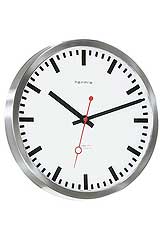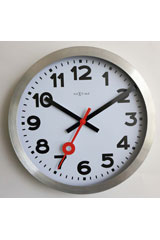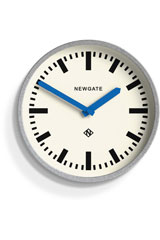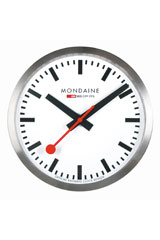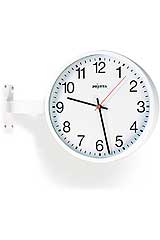Station clocks
Station clocks for all living areas
Station clocks are unagitated, clear and sober. They have become absolute classics thanks to their clean lines. The design of station clocks is unique, memorable and useful. Thanks to the clean lines and the size of station clocks, they are very easy to read. These features make the station clock ideal not only for train stations and other public spaces, but also for the home at home. Classically, station clocks are analogue and the color white dominates. The black hands are concise and partly supplemented by a red second hand. The Swiss watch brand Mondaine has dedicated itself to this special design. A special distinguishing feature is the red trowel as a second hand in the form of the red trowel of the Swiss Federal Railways. Mondaine offers both wall>mounted and in this style. Other brands that stand out for their quality and clear design are GER-Technik and Nextime.
Swiss reliability
The station clock changed the world
The station clock has changed the world from North America. Train travel was still very expensive in the USA around 1840. Since then, the mail has been transported by train. For those waiting for the mail and travelers, however, the up to 70 different regional times in the USA were a major annoyance. In order to bring some order to this jumble of different times, and to ensure that the passengers did not have to be completely confused, several clocks of different times were installed at stations. The station clock was born. Unfortunately, this did not help enough. There were still too many times to consider. The American Charles Dowd proposed dividing the United States into four time zones. In November 1883, these time zones are the standard time at all North American railroads and post offices. Of course, this time had to be awarded in all official places. And so the station clock continues to spread. In 1900, this system was adapted for the whole world and the 24 time zones of the world were created.
Simple and intriguing design
It is not uncommon for the hanging of a station clock to completely change the impression of space in an apartment and create a completely new sense of space. It is precisely this contrast of hanging a clock in one's own home, which is actually at home in the transport sector, that is very much in demand. The large clocks also look very good in the office. They are definitely an eye-catcher.
Timeless and elegant are just a few attributes that apply to the wall-mounted station clocks. Due to their minimalist design, they offer an ideal counterpoint to playful home furnishings. Nowadays, the minimalist aspect of this is often associated with the words retro or antique. Also because the simple elegance of the station clocks can hardly be found anywhere else in today's world.
Choose your preferred payment
You can choose the following payments from our shop: PayPal, credit card and prepayment. For more information visit payment methods & FAQ More payments: prepayment with 3% off for wristwatches
INFORMATION
Last update 2024-05-12 23:45:06


